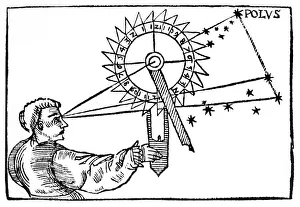Apian Collection
"Apian: Exploring the Cosmos in the 16th Century" Step into the world of Peter Apianus, a renowned German astronomer and mathematician of the 16th century
All Professionally Made to Order for Quick Shipping
"Apian: Exploring the Cosmos in the 16th Century" Step into the world of Peter Apianus, a renowned German astronomer and mathematician of the 16th century. His contributions to cartography and celestial observations have left an indelible mark on our understanding of the universe. One of his notable works is the "Apian World Map, " created in 1530. This heart-shaped map depicts a unique perspective of our planet, with small portraits honoring Amerigo Vespucci, who played a significant role in exploring new lands. In his pursuit to unravel celestial mysteries, Apianus developed ingenious instruments like nocturnals for telling time at night. By measuring angular distances between stars or planets, astronomers could determine accurate hours even under starry skies. Another fascinating aspect was Apianus' use of astronomical sextants to measure the altitude of the sun. These precise tools allowed astronomers to calculate positions accurately and contributed greatly to advancements in astronomy during that era. The concept of eclipses also intrigued Apianus, leading him to develop methods for calculating solar and lunar events. His studies shed light on these mesmerizing phenomena that continue to captivate us today. Apianus embraced Ptolemaic cosmology, which placed Earth at the center of the universe before Copernicus revolutionized our understanding. Woodcuts from his famous work "Cosmographia" showcase this pre-Copernican worldview, offering glimpses into how people perceived their place within an expansive cosmos. Gemma Phrysius (1508-1555), a Dutch mathematician influenced by Apianus's teachings, can be seen holding an adjustable instrument in one portrait—a testament to how far-reaching his ideas were among fellow scholars. From measuring sun altitudes with ring dials to using astrolabes for steeple height calculations—these illustrations from "Cosmographia" demonstrate practical applications of Apianus' astronomical knowledge.











